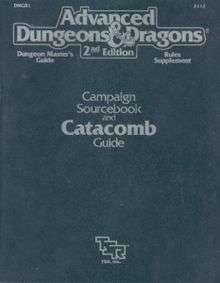Campaign Sourcebook and Catacomb Guide
Campaign Sourcebook and Catacomb Guide is an accessory for the Advanced Dungeons & Dragons fantasy role-playing game.
 | |
| Author | Paul Jaquays and William W. Connors |
|---|---|
| Genre | Role-playing game |
| Publisher | TSR |
Publication date | 1990 |
| Pages | 128 |
| ISBN | 978-0-88038-817-7 |
Contents
The Campaign Sourcebook and Catacomb Guide is a supplement to the Dungeon Master's Guide for the Advanced Dungeons & Dragons 2nd edition rules.[1] The first section of the book contains general guidelines to help Dungeon Masters (DMs) run campaigns, covering different styles of play, pacing and theatrics, creating campaigns and worlds, enacting believable non-player characters, and make useful maps.[1] The second part of the book covers running games in dungeons, with rules for underground conditions and instructions for drawing maps in perspective; included are samples of six different styles of dungeon environment.[1]
Publication history
DMGR1 Campaign Sourcebook and Catacomb Guide was written by Paul Jaquays and William W. Connors, and published by TSR in 1990 as a 128-page book.[1] Editing was done by William W. Connors and Warren Spector.[2]
Reception
Ken Rolston reviewed the Campaign Sourcebook and Catacomb Guide for Dragon magazine in July 1991.[2] He gave the book a very positive review, noting in particular the high quality of the details on mapping, the tips for using props and for creating and presenting vivid NPCs, and the simple guidelines for world building.[2] He found the chapter rationalizing the existence of dungeons "marginally persuasive and thoroughly entertaining", and felt the book addresses all the questions he had heard from "earnest, troubled young DMs at convention seminars".[2] He described the writing as "simple, lean, and humorous [...] full of veteran wisdom, play experience, and practical insight into gamer behavior".[2] He found it odd there had never been a good book on game mastering before, noting the book reminded him of many principles and tricks he had learned through "hard experience and obsessive study of other DMs' styles and cheap tricks".[2] He concluded the review by addressing DMs: "Beginners: You want this solid introductory reference for its ironic, practical, and amusing advice on creating, organizing, and presenting role-playing adventures and campaigns. Veterans: Enjoy this readable, amusing review of the basic problems and approaches to being an effective DM."[2]
References
- Schick, Lawrence (1991). Heroic Worlds: A History and Guide to Role-Playing Games. Prometheus Books. p. 92. ISBN 0-87975-653-5.
- Rolston, Ken (July 1991). "Role-playing Reviews". Dragon. Lake Geneva, Wisconsin: TSR (171): 83.